#Maria Trastamara
Explore tagged Tumblr posts
Text
No more Tudors, please—unless it’s Mary I or Edward VI. Let’s focus on the Trastámaras, especially Catherine of Aragon, and delve into the Habsburgs, like Margaret of Austria and her nieces: Eleanor, Isabella, Maria, and Catalina. And don’t forget Charles V and his brother Ferdinand! We need more content on the Trastámara and Habsburg dynasties, as well as Stuart topics that aren’t about Mary, Queen of Scots or Stuart England.
#history#tudor era#mary i of england#mary i#catherine of aragon#catalina de aragon#margaret of austria#eleanor of austria#isabella of austria#maria of austria#charles v#ferdinand i#mary queen of scots#mary stuart#stuart dynasty#trastamara dynasty#enoug with the elizabeth i stuff#gimme mary i
32 notes
·
View notes
Text
Minor Women in The Witcher 3:
Note: this is not the full list of every woman found in-game, however a list of many minor woman that do appear.
• Anabelle - Plague maiden from Fyke Island. In love with a local fisherman (Graham) but her father (Lord of Velen) disapproved. During a Nilfgaardian invasion, fled to Fyke Island to hide in a mage tower with her family. Took a paralysis potion to protect herself from assault when peasants stormed the tower, however when she woke she was unable to move, everyone else was dead, and rats descended on them, hence her ghost from a grisly death.
• Anna Strenger - Wife of the Bloody Baron, mother of Tamara Strenger. Fled from the Baron, his drunken rages and beatings, with her daughter. The Crones placed a curse on her which turned her into a monster after making a pact with them to abort her pregnancy, and she is dragged into Crookback Bog to repay her debt.
• Anisse - Young Aretuza graduate.
• Aynara - orphan found in Crookback Bog.
• Bea - Barmaid in Novigrad, non-human sympathiser and a friend of Ciri.
• Bergthora - Wife of Eiric in Skellige.
• Birna Bran - Widow of the King of Skellige, engaged in a conspiracy that ends in a massacre at Kaer Trolde due to her disdain with customs and wish to establish a hereditary rulership.
• Carthia van Canten (Cantarella/Sasha) - Head of Nilfgaardian Secret Service.
• Catarina - Actor in the Foxen.
• Corinne Tilly - Oneiromancer (deciphering the past and present in dreams).
• Dolores Reardon - Old woman, ran away from her Temerian wealthy family with her lover.
• Dora - young woman harassed by thugs who Geralt walks home (even though she can take care of herself).
• Edna var Attre - Daughter of a Nilfgaardian ambassador, twin sister to Rosa.
• Elsa - Innkeeper in White Orchard.
• Eveline Gallo - Circus acrobat, accomplished thief and an elf.
• Felicia Cori - Young aspiring sorceress, former Philippa pupil, burned by the Church of the Eternal Fire.
• Gretka - Girl which Ciri saves from wolves in Velen.
• Ingrid Vegelbud - Daughter of Patricia Vegelbud.
• Irina Renarde - Leader of the Foxen (Mummers troupe), an actor.
• Jacquette - Young woman who is engaged to a knight errant of Toussaint.
• Jonna - Alchemist in Rannvaig.
• Josta - Priestess of Freya.
• Jutta an Dimun - Shield maiden on Faroe, clan Dimun.
• Karli - Mother of two sons killed by a dragon in Fyresdal.
• Kurisu - Kidnapped by pirates, escapes and is found around Freyas Temple.
• Lena - Young woman attacked by a griffin while sneaking out to meet her Nilfgaardian lover.
• Liesje - Farmer and wife in White Orchard.
• Marabella - Teacher in Novigrad, poet and fond of horses.
• Margrit (Margaret) - Sister of Niellen's missing wife.
• Maria Louisa La Valette - Foltests mistress. A baroness, has two illegitimate children by Foltest.
• Marlene de Trastamara - Noble woman who turns away the wrong beggar and is cursed.
• Marquise Serenity - Madame at the Passiflora.
• Matilda de Vermentino - Owner of the Vermentino vineyard.
• Molly - Maid or noblewoman, depending on previous player choices.
• Nissa - Elven comedienne in The Puffins troupe.
• Patricia Vegelbud - Matriach of the Vegelbud family.
• Pinastri - Lapsed Eighth Day Flagellant, herbalist.
• Polly - Choreogapher in Novigrad. Dandelion used to hide out in her house.
• Rosa var Attre - Daughter of the Nilfgaardian ambassador, twin sister of Edna. Fencer.
• Sara - Godling "haunting" a house in Novigrad.
• Sweet Nettie - Sex worker, potential serial killer victim.
• Tamara Strenger - Witch hunter, daughter of the Bloody Baron. Fled with her mother, and joined the witcher hunters so she would be able to survive trekking into the bog to save her.
• Thecla - Wise woman in the village below Bald Mountain. Seeress.
• Vernossiel - Leader of a small Scoia'tael commando group.
• Viki - Shipwreck survivor, sheltering a young boy in Widows grotto.
• Vivienne de Tabris - Lady in waiting to Anna Henrietta. Cursed to turn into a bird when the moon is out.
26 notes
·
View notes
Text
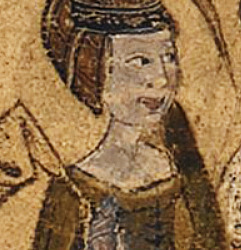
Isabel of Castile, First Duchess of York
Isabel was the third of four children of King Pedro I, also known as Pedro the Cruel, who ruled the Crown of Castile from 1350. Her mother was the vivacious and intelligent Maria de Padilla, often described as Pedro's mistress. In 1361, when Isabel was only six, her mother died. The following year, Pedro declared that he and Maria had been lawfully married before he was forced to espouse his estranged French wife, Blanche of Bourbon, who was by then also dead, some said murdered by her husband. His claim of an earlier marriage was subsequently endorsed by the Cortes, thus legitimising Pedro's children by Maria. Pedro was killed by his illegitimate half-brother and deadly enemy Enrique of Trastámara in March 1369. Trastámara became King Enrique II of Castile.
Isabel accompanied her elder sister Constanza to England, and married Edmund of Langley, son of Edward III and Philippa of Hainault, in 1472 at Wallingford, as part of a dynastic alliance in furtherance of the Plantagenet claim to the crown of Castile. Isabel was only 16 or 17 to Edmund’s 31, and brought him no lands or income or even the promise of such because her sister Constanza – who married Edmund’s elder brother John of Gaunt as his second wife – was their father’s heir. John and Constanza spent many years trying unsuccessfully to claim her late father’s throne from her illegitimate half-uncle Enrique of Trastamara, while Edmund and Isabel were required to give up any claims to the kingdom of Castile and were not compensated.
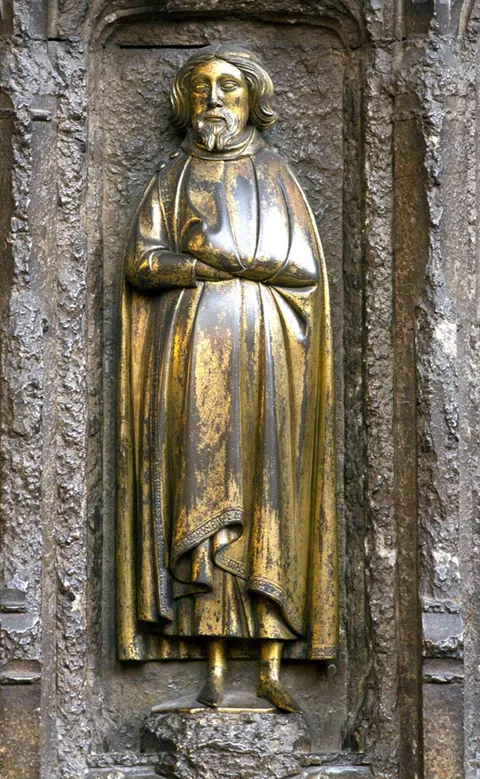
As a result of her marriage, Isabel became the first of a total of eleven women who became Duchess of York. She was appointed a Lady of the Garter in 1379. In their twenty years of marriage, the Duke and Duchess of York had three children:
Edward of Norwich, Duke of York
Constance
Richard of Conisburgh, Earl of Cambridge
Contemporary sources suggest that Edmund and Isabel were an ill-matched pair and their relationship was a rocky one, with Isabel accused of having an affair with John Holland, Duke of Exeter and half-brother to Richard II. The affair is believed to have started as early as 1374 and likely continued for a decade. As a result of her indiscretions, Isabel left behind a tarnished reputation. The chronicler Thomas Walsingham considered her to have somewhat loose morals.
John Holland has also been suggested as the real father of Isabel’s youngest son, Richard of Conisburgh, who was the grandfather of Edward IV and Richard III. The fact that his father Edmund of Langley and brother Edward, both, left him out of their wills has fuelled this theory. However, leaving a son out of your will was not entirely unusual, and Richard had died when his brother made his will.

Isabel of Castile died in December 1392 at the age of about 37 and was buried at Langley Priory in Hertfordshire. In her will, Isabel left items and gifts of money to close relatives by blood or marriage, and to numerous servants of hers, men and women. Isabel referred to Edmund of Langley as her "very honoured lord and husband of York", and left him all her horses, all her beds including the cushions, bedspreads, canopies and everything else that went with them, her best brooch, her best gold cup, and her "large primer". Isabel named King Richard II as her heir, requesting him to grant her younger son, Richard, an annuity of 500 marks. Isabel left nothing at all to her older sister Constanza, duchess of Lancaster, and failed even to mention her. Isabel doesn't forget John Holland in her will, at this time married to Elizabeth of Lancaster, John of Gaunt's daughter.
About 11 months later her widower married Joan Holland, niece of Isabel's supposed lover, John Holland. In another bizarre family twist, it was Joan’s brother, Edmund Holland, Earl of Kent, who had an affair – and an illegitimate daughter – with Constance of York, the daughter of Edmund and Isabel. In Edmund’s own will of 1400 he requested burial ‘near my beloved Isabele, formerly my consort.’ Despite Isabel of Castile's bad reputation and supposedly having been involved in a court scandal that humiliated her husband, Edmund seems to have felt great affection for her as demonstrated by his willingness to rest eternally with Isabel and not with his second wife.
Source:
#Isabel of Castile#Edmund of Langley#Duchess of York#Duke of York#women in history#english history#spanish history
15 notes
·
View notes
Text

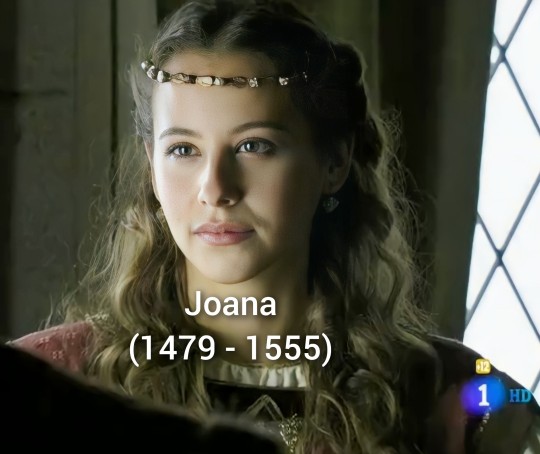


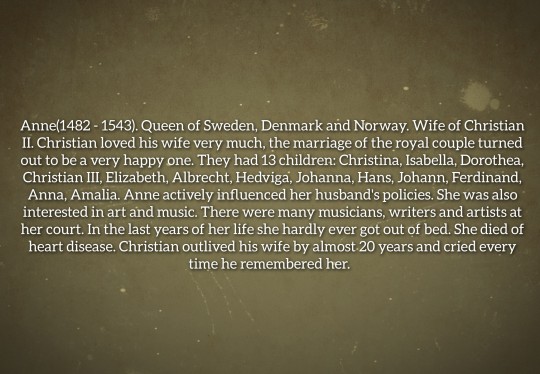
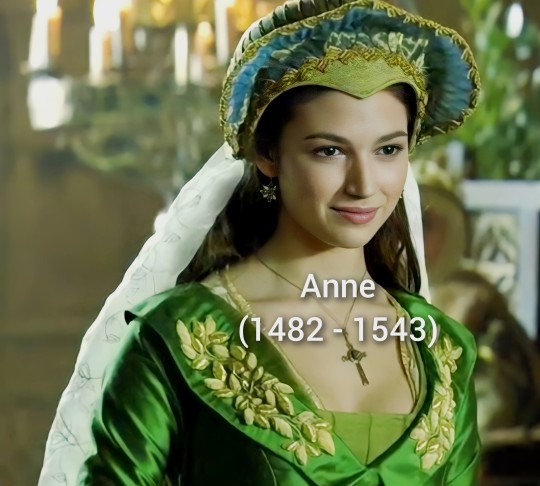



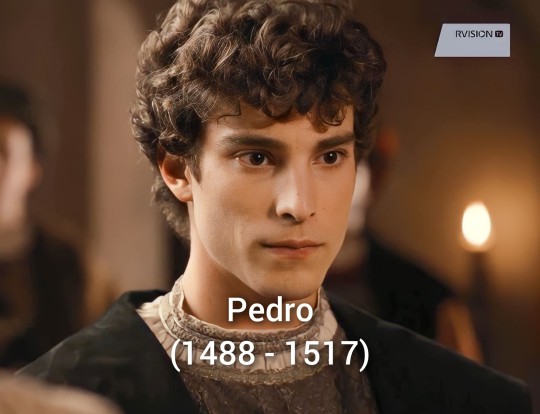
AU House of Trastamara: Children Isabella of Castile and Ferdinand of Aragon.
Joana(1479 - 1555). Duchess of Burgundy. Wife of Philip I of Austria. Mother of 6 children: Eleanor, Charles V, Isabella, Ferdinand, Maria, Catherine. Joana lived a long and interesting life. After the untimely death of her husband, she became regent under her infant son Charles. And after her son became emperor, he made her ruler of the Netherlands. Joana outlived not only her husband, but all of her siblings and even got to see her great-grandchildren. She died surrounded by her children and grandchildren.
Mary(1482 - 1550). Queen of Scots. Wife of James IV. Mary and James IV maintained a warm relationship throughout their marriage. The queen supported her husband in everything, but the king preferred her to his favorite. The marriage produced 7 children: James V, Margaret, Isabella, Matilda, Robert, Anabella and David. After her husband's death, she devoted herself to culture and art.
Anne(1482 - 1543). Queen of Sweden, Denmark and Norway. Wife of Christian II. Christian loved his wife very much, the marriage of the royal couple turned out to be a very happy one. They had 13 children: Christina, Isabella, Dorothea, Christian III, Elizabeth, Albrecht, Hedviga, Johanna, Hans, Johann, Ferdinand, Anne, Amalia. Anne actively influenced her husband's policies. She was also interested in art and music. There were many musicians, writers and artists at her court. In the last years of her life she hardly ever got out of bed. She died of heart disease. Christian outlived his wife by almost 20 years and cried every time he remembered her.
Catherine(1485 - 1543). Queen of England. Wife of Prince Arthur and then his brother Henry VIII. Mother of 6 children: Elizabeth, Henry IX, William, Edmund, Mary, Isabella. The marriage of Henry and Catherine was a happy one. She exerted political influence on her husband. In addition, Catherine paid great attention to the upbringing and education of her children, and she maintained close communication with all her brothers and sisters.
Pedro(1488 - 1517). Grand Master of the Order of Calatrava. Count de Ampurias. Married Henry VIII's sister, Margaret Tudor. Father of 3 children: Jaime, Yolanda, Fadrique. Together with his older brothers took part in military campaigns. He died on the battlefield. After the death of his brother, Alfonso took his wife and his nephews to the palace.
AU: Дети Изабеллы Кастильской и Фердинанда Арагонского.
Хуана(1479 - 1555). Герцогиня Бургундская. Жена Филиппа I Австрийского. Мать 6 детей: Элеонора, Карл V, Изабелла, Фердинанд, Мария, Екатерина. Хуана прожила долгую и интересную жизнь. После скоропостижной смерти своего супруга стала регентом при малолетнем сыне Карле. А после того как её сын стал императором он сделал её правительницей Нидерландов. Хуана пережила не только мужа, но и всех своих братьев и сестёр и даже смогла увидеть своих правнуков. Умерла в окружении детей и внуков.
Мария(1482 - 1550). Королева Шотландии. Жена Якова IV. Между Марией и Яковом IV на протяжении всего брака сохранялись тёплые отношения. Королева во всем поддерживала своего мужа, но король предпочитал ей свою фаворитку. В браке родилось 7 детей: Яков V, Маргарита, Изабелла, Матильда, Роберт, Анабелла, Давид. После смерти мужа она посвятила всю себя культуре и искусству.
Ана(1482 - 1543). Королева Швеции, Дании и Норвегии. Жена Кристиана II. Кристиан очень любил свою жену, брак королевской пары оказался очень счастливым. У них родилось 13 детей: Кристина, Изабелла, Доротея, Кристиан III, Елизавета, Альбрехт, Хедвига, Иоанна, Ганс, Иоганн, Фе��динанд, Анна, Амалия. Ана активно влияла на политику своего мужа. А также она интересовалась искусством и музыкой. При её дворе было много музыкантов, писателей и художников. В последние годы жизни она почти не вставала с постели. Умерла от сердечной болезни. Кристиан пережил свою жену почти на 20 лет и каждый раз плакал когда о ней вспоминал.
Екатерина(1485 - 1543). Королева Англии. Жена принца Артура, а затем его брата Генриха VIII. Мать 6 детей: Елизавета, Генрих IX, Уильям, Эдмунд, Мария, Изабелла. Брак Генриха и Екатерины был счастливым. Оказывала политическое влияние на своего мужа. Кроме этого Екатерина уделяла большое внимание воспитанию и образованию своих детей, а также она поддерживала тесное общение со всеми своими братьями и сёстрами.
Педро(1488 - 1517). Великий Магистр ордена Калатравы. Граф де Ампурьяс. Женился на сестре Генриха VIII, Маргарите Тюдор. Отец 3 детей: Хайме, Иоланда, Фадрике. Вместе со старшими братьями принимал участие в военных походах. Погиб на поле боя. После смерти брата Альфонсо забрал его жену и своих племянником во дворец.
Part 2.
#history#history au#spanish#spanish history#royal family#royalty#the tudors#isabella#Isabella of Castile#isabella of portugal#Ferdinand of Aragon#catherine of aragon#Henryviii#15th century#16th century#mary tudor#au#spanish princess#spain#spanish royal family#the spanish princess#spanish royalty#Roy#Royal#Royals
11 notes
·
View notes
Text
Sixtended OC's Height Chart
I think this was long overdue. This is a height chart to all of the current Sixtended Verse OCs on Tumblr. I will update once new ones are made. I did both types just in case. Updated (October 10, 2024)
I like to thank @altairtalisman for the chart I used as a reference and both them and Finch for the help
Amalia “Mali” by @pandora-dusk - 5'3ft or 160.02cm (160)
Anne “Anya” by @toasty-owl-arts - 5'2ft or 157.48cm (157.5)
Anne “Ann” by yours truly - 5'8ft or 172.72cm (172.7)
Arthur Tudor by @djts-arts - 6′2ft or 187.96cm (188)
Cathryn Carey by @weirdbutdecentart - 5'1 or 154.94cm (154.9)
Christina of Denmark by @the-fox-arts - 5′7ft or 170.18cm (170.2)
Dorothy"Roth" by @altairtalisman - 5'4ft or 162.56cm(162.6)
Edward VI by @ratscraftz -5′7ft or 170.18cm (170.2)
Elisabeth "Sisi" by @ratscraftz - 5'6ft or 167.64cm(167.6)
Elizabeth "EB" by @spooner7308 - 5'11ft or 180.34cm (180.3)
Elizabeth ‘Liz’ Seymour by @vancsssa - 5′7ft or 170.18cm (170.2)
Elizabeth “Ellie” Tudor by @me-tizi - currently 4′3ft or 129.54cm (129.5), but will be 5′4ft or 162.56cm (162.6)
Ferdinand II by @weirdbutdecentart - 6'3ft or 190.5cm
George Boleyn by @ellielovesdrawing - 6'4ft or 193.04cm (193)
Guilford Dudley by @ratscraftz 5'8ft or 172.72cm (172.7)
Hans Holbein the Younger by @podsn - 6′0ft or 182.88cm (182.9)
Hans Holbein the Younger by @redlover411 - 5’9ft or 175.26cm (175.3)
Henry Carey by @weirdbutdecentart - 5'0ft or 152.4cm
Henry “Hal” by @blackdiamondwrites127 - currently growing, but will be 6'2ft or 187.96cm (188)
Henry "Fitz" FitzRoy by @sixaustralia - 5'11ft or 180.34cm (180.3)
Henry Percy by @cheemken - 6'3ft or 190.5cm
Isabella of Castille by @weirdbutdecentart - 6'2ft or 187.96cm (188)
Isabella Trastamara by @lexartsstuff - 5'5ft or 165.1cm
Isabella “Izzi” Trastàmara by @weirdbutdecentart - 3'7ft or 109.22cm (109.2)
Jane "Janey" Grey by @ratscraftz - 5'1ft or 154.94cm (154.9)
Jane “JP” by @altairtalisman - 5'8ft or 172.72cm (172.7)
John Astley by @yourdeepestfathoms - 6′0ft or 182.88cm (182.9)
Juan Trastàmara by @weirdbutdecentart - 6'1ft or 185.42cm (185.4)
Juana “Ju-Ju” by @ellielovesdrawing - 5'11ft or 180.34cm (180.3)
Katherine “Kat” Ashley by @yourdeepestfathoms - 5'11ft or 180.34cm (180.3)
Katherine “Kath” Tudor by @ellielovesdrawing - 5'0ft or 152.4cm
Lillia "Lily" Trastamara by @ellielovesdrawing - currently 4'11ft or 149.86cm (149.9), but will be 5′7ft or 170.18cm (170.2)
Margaret “Maggie” of Austria by @weirdbutdecentart - 6'0ft or 182.88cm (182.9)
Margaret Beaufort by @redladydeath - 5′7ft or 170.18cm (170.2)
Margaret “Meg” by @me-tizi - 5′8ft or 172.72cm (172.7)
Maria of Jülich-Berg by @blackdiamondwrites127 - 5'1ft or 154.94cm (154.9)
Maria Trastámara by @blackdiamondwrites127 - 5′7ft or 170.18cm (170.2)
Marion Trastámara by @vancsssa - 5'2ft or 157.48cm (157.5)
Mark Smeaton by @ellielovesdrawing - 6'1ft or 185.42cm (185.4)
Mary “Mara” Boleyn by @mariegreythepoet - 5′6ft or 167.64cm (167.6)
Mary Fitzroy-Howard by @sixaustralia - 5′3ft or 160.02cm (160)
Mary Stuart by @to-the-world-we-dream-about - 6′0ft or 182.88cm (182.9)
Mary “Marie” by @me-tizi - 5′5ft or 165.1cm
Mary I "Mari" by @crimsonnight186 - 5'9ft or 175.26cm (175.3)
Robert Dudley by @ratscraftz 5'9ft or 175.26cm (175.3)
Sibylle of Cleves by @blackdiamondwrites127 - 6′4ft or 193.04cm (193)
Thomas More by @spooner7308 - 5′6ft or 167.64cm (167.6)
William of Jürich-Cleves-Berg by @lexartsstuff - 6′0ft or 182.88cm (182.9)
Will Parr by @weirdbutdecentart - 6'1ft or 185.42cm (185.4)
Willie Strafford by @weirdbutdecentart - 5'9ft or 175.26cm (175.3)
#six the musical#Six OC#Sixtended verse#Amalia of Cleves#Anya Askew#Ann Parr#Arthur Tudor#Christina of Denmark#Elizabeth Barton#Elizabeth Seymour#Elizabeth Tudor#George Boleyn#Hal Aragon#Hans Holbein#Henry Percy#Isabella Trastamara#Jane Parker#John Astley#Juana de Castille#Katherine Ashley#Katherine Tudor#Margaret Beaufort#Margaret Tudor#Mary Boleyn#Mary Fitzroy-Howard#Mary Stuart#Maria Trastamara#Mark Smeaton#Mary Tudor#Sibylle of Cleves
67 notes
·
View notes
Note
Are you still doing the pick a scene thing? If so, Maria(sixtended) with r2 please!

#Maria Trastamara#SIXtended#sixtended verse#now someone request me to draw Lina cause one of the pages is gonna be the Trastamara sisters#should I also add Hal and Mary in the page?#Dj's doodles
14 notes
·
View notes
Photo



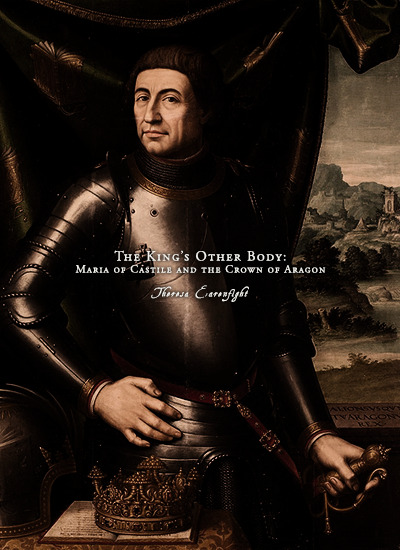

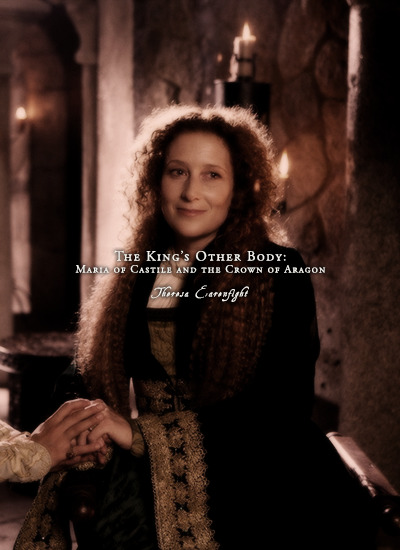
Favorite History Books || The King’s Other Body: María of Castile and the Crown of Aragon by Theresa Earenfight ★★★★☆
Queen María of Castile, wife of Alfonso V “the Magnanimous,” king of the Crown of Aragon (1416– 58), governed Catalunya from 1420 to 1423 and again from 1432 to 1453 while her husband was occupied with the conquest and governance of the kingdom of Naples. For twenty-six years she had control over the provincial governors, prelates and religious orders, the nobility, the army, the municipal government, and all other subjects regardless of legal status. She could grant constitutions and make laws in accordance with royal authority and could sign letters in her own hand according to her own conscience. She was empowered to carry out justice, both civil and criminal, and to name judges and delegates. Assisted by a royal council separate from the king’s, she had full royal authority in Catalunya.
Such legitimately sanctioned political authority in the hands of a queen is remarkable because María governed Catalunya not as queen in her own right, or even as queen-regent, but rather as lieutenant general (lloctinent general). In the privilegios that named María lieutenant, Alfonso clearly stated that her powers as lieutenant should be equivalent to his own as king, referring to her as his alter nos. María was clearly more than just a wife offering advice: She held the highest political office in the most important of Alfonso’s Iberian realms and, in political terms, was second only to the king himself. For a medieval queen, this combination of exalted royal status plus official political appointment was not common and may not have existed outside the realms of the Crown of Aragon. But in the Crown a unique contractual form of kingship and government had developed that relied heavily on delegated authority to rule the far-flung constituent territories in the Mediterranean. Established in the thirteenth century, the lieutenancy was both an ad hoc adjunct to the king and a training ground for princes to rule one or more of the constituent realms of the Aragonese crown. The institution was the by-product of innovation brought on by rapid territorial acquisition during the thirteenth and fourteenth centuries— encompassing the kingdom of Aragón, the county of Catalunya, the Balearic Islands (Mallorca, Menorca, and Ibiza), Valencia, Sardinia, and Corsica— that stretched across the western Mediterranean. This widely dispersed geography forced the kings to travel frequently and delegate authority normally reserved to the king to their wives, sons, and brothers. As an official form of co-rulership it is, to my knowledge, unique.
… This bare outline of her reign tells us much about rulership in the Crown of Aragon in the later Middle Ages. But more broadly it makes a compelling argument for a reformulation of our understanding of the place of queenship in the institution of monarchy. María of Castile, and an Aragonese queen-lieutenant in general, may be unfamiliar to most scholars of the Middle Ages, and she may seem anomalous and her experience ungeneralizable to the rest of Europe, but her case exposes the limitations of current explanatory models of queenship. She did not rule in her own right, so comparisons with female rulers like Urraca of Leon-Castile, Isabel of Castile, and Juana of Castile are misleading. Even though she married an Aragonese prince and derived her office as queen-lieutenant from her marriage, she does not fit the typologies that analyze queenly power in the context of marriage and motherhood— queen-consort, queen-mother, queen-regent, and queen-dowager. She had no children and thus could not be queen-regent for them in their minorities and could not exercise a queen-mother’s privilege to act as diplomat when arranging the marriages of her children and grandchildren. She could she serve as queen-dowager because she died a few months after Alfonso and his brother succeeded him immediately. María’s reign typifies the idiosyncratic character of the office of queenship, poised ambiguously between family and bureaucracy.
#historyedit#litedit#maria of castile#medieval#spanish history#house of trastamara#european history#women's history#history#nanshe's graphics#history books
44 notes
·
View notes
Text





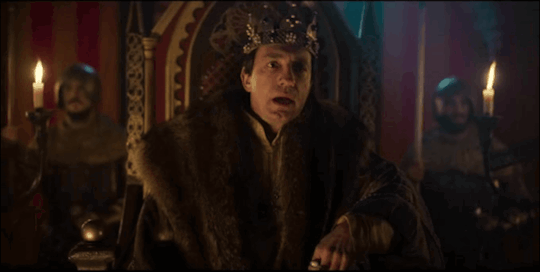

A guide through the monarchs of Aragon in La Catedral del mar & Los Herederos de la tierra
@asongofstarkandtargaryen
During the series the role of the members of the monarchy is secondary, but they are used to help to establish a concrete historical context and they're very determinant in the situation of the Puig and Entanyol families involving political estrategies of supporting this or that king, that gave them benefits or dacay (Arnau's rise with Pedro IV, Genís & Roger rise with Juan I and Martín I and Bernat with Fernando I). So, I wanted to make a recopilation of the monarchs shown during these series and their families.
House of Aragon/ House of Barcelona (descendants of the Jimena dinasty)
The Jimena dinasty is called like that because its origin was Jimeno "the Strong", grandfather of Eneko Arizta, and one of its branches was the Arista-Iñiga dinasty started by Eneko.
Eneko, his son García Iñiguez and his grandson Fortún Garcés were Lords of Pamplona, Fortún Garcés married Awriya bint Lubb ibn Musa (great-grandaughter of Musa the Great), and one of their daughters was Oneka Fortúnez, who married Abd Allah I of Cordoba (their son was Muhammad, who fathered the calipha Abd al-Rahman III with a basque woman called Muzna) and then Oneka married Aznar Sánchez de Larraún, and had a daughter with him, Toda Aznárez. Toda married Sancho Garcés I, the truly first king of Pamplona, was Sancho Garcés I (the first king of the Jimena dinasty).
Sancho Garcés III (992-1036) was king of Pamplona, Count of Aragon and king consort of Castile, whose bastard son with Sancha de Aibar, Ramiro I, inherited the counties of Aragon, Sobarbe and Ribagorza, and united them to form the kingdom of Aragon.
Then Petronila I (1136-1173), Ramiro I's great-grandaughter, married Ramón Berenguer IV count of Barcelona. Their son Alfonso II of Aragon was the first king of the Crown of Aragon and Pedro IV's great-great- great-grandfather.
In summary all the Aragonese monarchs are descedants of Eneko Arizta (and that's the way we can link Irati with LCDM/LHDLT)
Pedro IV
Pedro IV of Aragon, II of Valencia and I of Mallorca (Balaguer, Lleida, Catalonia, September 5, 1319 - Barcelona, Catalonia, January 5, 1387), called "the Ceremonious" or the Punyalet ('the one with the dagger', due to a dagger he used to carry), son of Alfonso IV of Aragon and Teresa de Entenza.
King of Aragon, Valencia and Mallorca (1344-1387); Duke of Athens (1380-1387) and Neopatria (1377-1387); count of Barcelona (1336-1387) and of Ampurias (1386-1387).
In 1338 he married María de Navarra (1326-1347), daughter of Felipe III and Juana II of Navarra. Offspring:
Constanza (1343-1363), married in 1361 to Federico III of Sicily, and Juana (1344-1385), married in 1373 with Juan I de Ampurias.
In 1347 he married Leonor of Portugal (1328-1348), daughter of Alfonso IV of Portugal. She died the following year of the Black Death.
In 1349 he married Eleanor of Sicily (1325-1375), daughter of Pedro II of Sicily. Offspring:
Juan I (1350-1396), Martin I (1356-1410) and Leonor (1358-1382), married to Juan I of Castile. Leonor was the mother of Fernando I of Aragon.
In 1377 he married Sibila de Fortiá, daughter of the Empordà nobleman Berenguer de Fortiá. Offspring:
Isabel (1380–1424), who married Jaime II of Urgel, future suitor for the aragonese crown.
During his reign the Aragonese expansionism in the Mediterranean continued, focused on southern Italy and Greece.
Although he was ally of Alfonso XI, Pedro IV had a great rivalry with his son Pedro I of Castile and fought against him in some conflicts, like the War of the two Pedros (1356-1369) and the first Castilian Civil War (1351-1369), in which Pedro I was supported by Pedro I of Portugal (one of his bastard sons, Juan I of Portugal, was the founder and first king of the Avis dinasty) and Muhammad V of Granada, and Pedro IV supported the bastard children of Alfonso XI with his lover Leonor de Guzmán (Pedro de Aguilar, Sancho Alfonso, Fadrique Alfonso, Enrique II of Castile, Fernando Alfonso, Tello, Juan Alfonso, Juana Alfonso, Sancho and Pedro Alfonso), who started several revolts against Pedro I of Castile. The wars ended when Enrique killed Pedro I, and he became the first king of Castile of the Trastamara dinasty.
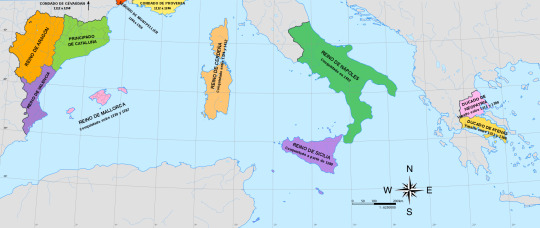
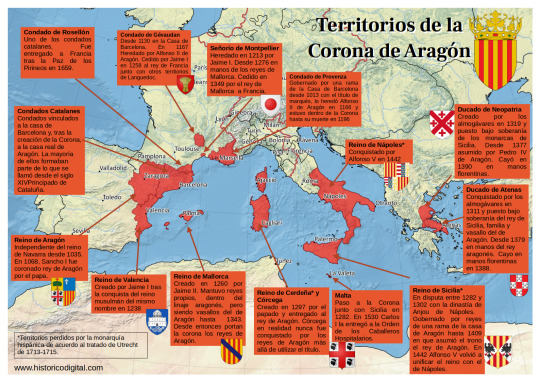
Sibila de Fortiá
Sibila de Fortiá (Fortiá, Girona, Catalonia, 1350 - Barcelona, Catalonia, 1406), queen consort of the Crown of Aragon (1377-1387). She was the daughter of Berenguer de Fortiá and his wife Francesca de Vilamarí. In 1371 she married for the first time Artal de Foces, an Aragonese nobleman, whom she widowed in 1374, and then she the lover of Pedro IV and had a daughter with him, Isabel.Pedro and Sibila married in 1377. After the wedding, Pedro surrounded himself with Empordà nobles as well as Sibila's relatives.
Pedro IV was very ill at the end of the year 1386, and Sibila, fearful of the wrath of the future King Juan, fled to the castle of San Martín de Sarroca (Barcelona), which belonged to her brother Bernat de Fortiá. There she was imprisoned by Juan I, who treated her harshly, accusing her of abandoning the king on his deathbed and of several robberies in the palace. She was confined in the castle of Moncada (Barcelona) until she renounced his property granted by the king. Finally, Sibila retired to the convent of San Francisco in Barcelona, where she died in 1406.
Juan I
Juan I of Aragon, called the Hunter or the Lover of All Kindness (Perpignan, Occitania, France, 1350 - Torroella de Montgrí, Girona, Catalonia, 1396), King of Aragon, Valencia, Mallorca, Sardinia and Corsica, and Count of Barcelona, Roussillon and Cerdanya ( 1387-1396). Son of Pedro IV and Leonor of Sicily.
His first marriage was with Marta de Armagnac (1347-1378), daughter of Count Juan I de Armagnac. With whom he had: Jaime (1374), Juana, (1375-1407) who married Mateo, Count of Foix. After the death of her father, she claimed the throne with her husband, but they were defeated; Juan (1376), Alfonso (1377) and Leonor (1378).
Widowed, Juan married Violante de Bar (1365-1431), daughter of Robert I, Duke of Bar. Offspring:
Jaime Duke of Girona (1382-1388), Yolanda, who married Louis II of Anjou, titular king of Naples. Their son, Luis III, claimed the throne after the death of Martín I, in the engagement of Caspe; Fernando Duke of Girona (1389), Antonia (1391-1392), Juan Duke of Girona (1392-1396), Eleanor (1393), Pedro Duke of Girona (1394) and Juan (1396)
Martin I
Martin I of Aragon, also called the Human or the Old (Girona, July 29, 1356-Barcelona, May 31, 1410), was king of Aragon, of Valencia, of Majorca, of Sardinia and count of Barcelona (1396-1420) and king of Sicily (1409-1410). Second son of Pedro IV of Aragon and his third wife Leonor of Sicily.
Martín was called "the Human" because of his great passion for the Humanities and books. The library of Martín I is the first that could be considered from Renaissance, if at that time in the history of the Iberian peninsula the term can already be used.
Martin married in 1372 with Maria de Luna, daughter of Lope, the first count of Luna, in 1374. From this union they were born:
Jaime (1378), Juan (1380) and Margarita (1388) and Martin I of Sicily "the Younger" (1376-1409), first husband of Blanca I of Navarra.
When Martin the Younger died, Martin married Margarita de Frades, although they left no issue.
His entire reign was marked by the Western Schism that divided Christianity since 1378. He was a supporter of the popes of Avignon (where he went the year of his coronation to swear allegiance to Benedict XIII "the Pope Luna", Pedro Martínez de Luna y Pérez de Gotor, with whom it seems that he came to establish a friendly relationship ), from whom he obtained support in his claims over the kingdom of Sicily against the Anjou, supporters of the popes of Rome. In 1400, he would marry his niece Yolanda to Louis II of Anjou in order to defuse tensions. He met in Avignon with the antipope Benedict XIII, Aragonese and a relative of the queen, with the intention of reaching a solution to the schism and, later, in 1403 he intervened militarily against the siege that Benedict suffered in his papal seat, rescuing him and welcoming him in Peñíscola .
House of Trastamara (the Aragonese branch)
Fernando I
Ferdinand I of Aragon (Medina del Campo, Valladolid, Castile and Leon, November 27, 1380-Igualada, April 2, 1416), also called Fernando de Trastámara and Fernando de Antequera, the Just and the Honest, was an infant of Castile, king of Aragon, Valencia, Mallorca, Sardinia, Count of Barcelona (1412-1416), and regent of Castile (1406-1415), during the minority of Juan II of Castile. Son of Juan I of Castile and Leonor of Aragon.
He was the first Aragonese monarch of the Castilian dynasty of the Trastámara, although he was of Aragonese origin on his mother's side.
He married Leonor de Alburquerque
Alfonso the Magnanimous (Medina del Campo, 1394-1458), king of Aragon, with the name of Alfonso V, and of Naples and Sicily, with the name of Alfonso I.
María de Aragón (Medina del Campo, 1396-1445), first wife of Juan II of Castile and mother of Enrique V of Castile
Juan II (Medina del Campo, 1397-1479), King of Aragon and King consort of Navarre.
Enrique (1400-Calatayud, 1445), II Duke of Villena, III Count of Alburquerque, Count of Ampurias, Grand Master of the Order of Santiago.
Leonor (1402-1445), who married Eduardo I of Portugal. Mother of Alfonso V of Portugal, Juana of Portugal (Enrique IV's second wife) and Leonor of Portugal, who married Frederick III of Habsburg (they were parents of emperor Maximilian I of Austria)
Pedro (1406-1438), IV Count of Alburquerque, Duke of Noto.
Sancho (1400-1416)
Alfonso V
Alfonso V of Aragon (Medina del Campo, 1396 – Naples, June 27, 1458), also called the Wise or the Magnanimous, king of Aragon, of Valencia, of Majorca, of Sicily, of Sardinia and Count of Barcelona (1426-1458); and King of Naples (1446-1458).
Alfonso V can be considered as a genuine prince of the Renaissance, since he developed an important cultural and literary patronage that earned him the nickname of the Wise and that would make Naples the main focus of the entry of Renaissance humanism in the sphere of the Crown of Aragon.
From his relationship with his lover Giraldona de Carlino, a napolitan noblewoman, he had three children:
Fernando (1423-1494), his successor in the kingdom of Naples under the name Fernando I.
Maria (1425-1449), married to Lionel, Marquis of Este and Duke of Ferrara.
Leonor, or Diana Eleonora (?-1450), married the nobleman Marino Marzano, Prince of Rossano.
Maria of Castile
María of Castile (Segovia, Castile and Leon, November 14, 1401-Valencia, October 4, 1458). Infanta of Castile, Princess of Asturias (1402-1405) and Queen of Aragon (1416-1458) for her marriage to Alfonso the Magnanimous. First daughter of Enrique III "the Mourner" and Catherine of Lancaster. Sister of Juan II of Castile, untie of Enrique IV and Isabel I.
The marriage between María and Alfonso is celebrated in the Cathedral of Valencia on October 12, 1415. The ceremony was officiated by the antipope Benedict XIII, who also granted the matrimonial dispensation for the wedding.
In 1420, when the king left for Naples for the first time, he left the government of his kingdoms in the hands of Maria as lieutenant general. The absence of the Magnanimous would last three years, during which María had to face the rapid deterioration of the economic situation in Catalonia, the territorial struggle with the Castilian Crown, as well as the conflicts of a social nature that shook her in different kingdoms. On his return to Aragon in 1423, Alfonso V began the war with Castile, along with his brother King Juan of Navarra. But her financial resources were exhausted and in 1429 Queen María had to act as a mediator between her husband and her brother, King Juan II of Castile, to put an end to the dispute. However, Alfonso's situation did not improve, due to the recession suffered by the Catalan economy and the social conflicts caused by it. The Courts of Barcelona in 1431 demanded from the king a series of measures to correct the enormous deficit of the Catalan treasury and trade. But Alfonso, fed up with these matters, returned to Italy and gave full powers to the queen as ruler of Aragon; he left the Iberian Peninsula forever on May 29, 1432. This marked Alfonso V's final break with the Crown of Aragon, which, however, he never renounced.
+ Bonus track (although he doesn't appear in this series)
Juan II
Juan II of Aragon and Navarra, the Great, or the Faithless according to the Catalan rebels who rose up against him (Medina del Campo, June 29, 1398-Barcelona, January 20, 1479) was Duke of Peñafiel, King of Navarre (1425-1479), King of Sicily (1458-1468) and King of Aragon, Mallorca, Valencia, Sardinia (1458-1479) and Count of Barcelona, son of Ferdinand I of Aragon and Leonor de Albuquerque.
From his first marriage to Blanca I of Navarra (daughter of Leonor of Castile and Carlos III of Navarra):
Carlos (1421-1461), Prince of Viana and Girona, Duke of Gandia and Montblanch, titular King of Navarra as Carlos IV (1441–1461), married Agnes of Cleves. He wrote the 'Chronicles of the Monarchs of Navarra', about the history of his antecessors, from Eneko Arizta in the 8th century up to the 15th century.
Juan (1423-1425)
Blanca of Navarra (1424-1464), first wife of Enrique IV of Castile
Leonor (1425-1479), married to Gastón IV de Foix, Queen of Navarre under the name of Leonor I.
From his second marriage to Juana Enríquez:
Leonor of Aragon (1448)
Fernando II (1452-1516), king iure uxoris of Castile (1474-1504) and then regent between 1507 and 1516, under the name of Fernando V due to his marriage to Isabel I, king of Sicily (as Fernando II, 1468-1516), Aragon and Sardinia (as Fernando II, 1479-1516), Naples (as Fernando III, 1504-1516), and from Navarra (as Fernando I, 1512-1516)
Juana (1455-1517), second wife of Fernando I of Naples. Her daughter Juana married Fernando II of Naples (Fernando I of Naples' grandson)
During his youth, Juan fought in the Castilian-Aragonese war (1429-30) and the Castilian Civil War (1437-1445) in the Aragonese team against Juan II of Castile, his son Enrique and the Constable Álvaro de Luna (favourite of Juan II), due to the Aragonese political influences in Castile and the full control that Álvaro de Luna had over Juan II of Castile that allowed him to become very powerful, so some members of the Castilian nobility wanted to remove Álvaro out of Juan II side because of that, and the Aragonese reacted to the anti-aragonese convictons of Álvaro.
Álvaro de Luna arranged a new marriage between Juan II of Castile and Isabel of Portugal (mother of Isabel I) in 1447. The constable intended with this dynastic alliance to strengthen the political ties that united Castile and Portugal against the common enemy: the Catalan-Aragonese Crown, but from 1449, Isabella of Portugal indirectly supported the maneuvers of the Great League of Nobles (allies of the Aragonese) formed against the constable. But it would not be until 1453 when Juan II of Castile, possibly tired of the continuous pressure from the aristocracy, left Álvaro on his own. It has often been said that it was the queen herself who demanded that her husband signed the prison order against Álvaro, through Juan Pacheco, Marquis of Villena.
By 1441 Blanca I de Navarra died and Juan II married the daughter of Fadrique Enríquez (one of his Castilian allies, the admiral of Castile), Juana Enríquez y Fernández de Córdoba.
After the death of Blanca I, a dispute between Juan II and Carlos de Viana about the sucession for the Navarrese throne. Juan was king Iure uxoris of Navarre and wanted to be keep his position as king, but Carlos and his supporters claimed that the prince was the rightful king as firstborn son of the queen and in 1451 the Navarrese civil war started.
In the following years the tension between Juan and Carlos increased with the birth of Fernando, who was pushed by his mother Juana to be the heir of Aragon and Navarra, which Juan later accepted. This change in the sucession was not accepted in Catalonia, that supported Carlos de Viana birthrights, and they started a rebellion against Juan II.
Other supporter of Carlos was Enrique IV, who offered his sister Isabel to Carlos in marriage as a sign of their alliance, but the wedding never happened.
Carlos died in 1461, although the war didn't ended because the Catalan nobility proposed other suitors for the Crown of Aragon and the Principality of Catalonia, like Enrique IV, Pedro of Portugal (grandson of Jaime II of Urgell) and Renato de Anjou during the Catalan civil war, that ended in 1472.
It's interesting that the interesting that the current situation of the Estanyol family at the end of Los Herederos de la tierra is that there are two brothers from different mothers, and whose father have benefited one of them over the other, so it may lead to tensions from the part that was not benefited, Arnau Jr is the main heir in Bernat's will, so maybe in the future Marta Destorrent will try to pit her son Baltasar against his elder brother to take Arnau Jr's place. By period of time I find very likely that this happens during the reigns Maria of Castile and Juan II, and the situation of the Estanyol succession could parallel the Carlos de Viana-Fernando II problem, although in this case the younger son was the benefited one and the one who inherited his father's kingdoms and maybe the Estanyols are part of the Catalan nobility that defended Carlos' birthrights, although some other Catalan nobles supported Juan II & Fernando alongside of peasants and smallfolk, during the First Remensa War during the Catalan civil war.
The Remensa War consisted in revolts organised by peasants who wanted to end the servitude to which their feudal lords had subjected them, so I think that probably the Estanyol-Llor family would support the peasants because of their backgrounds.
#la catedral del mar#los herederos de la tierra#the cathedral of the sea#heirs to the land#history#crown of aragon#aragonese monarchs#pedro iv de aragón#juan i de aragón#martín i de aragón#sibila de fortiá#fernando i de aragón#alfonso v de aragón#maria de castilla#juan ii de aragón#gifs#period dramas#house of aragon#house of trastamara#house of barcelona#long post
23 notes
·
View notes
Photo




♦ Daughters of Isabella I of Castile and Ferdinand II of Aragon
#history#historyedit#isabella of aragon#joanna of castile#juana of castile#maria of aragon#katherine of aragon#catherine of aragon#perioddramaedit#periodedit#isabella of castile#ferdinand ii of aragon#fancast#house of trastamara#tudors#habsburgs#tudorsedit#my edit#unlikely fancasts edition#that orange gown and headdress reminded me unexpectedly of juana's portrait and so
579 notes
·
View notes
Text
Trastámara Duckies
The context here is the same as @djts-arts 's post about the Trastámara siblings following Bella. I made a comment that they look like ducklings and everyone seemed to agree to that so have some duckies!
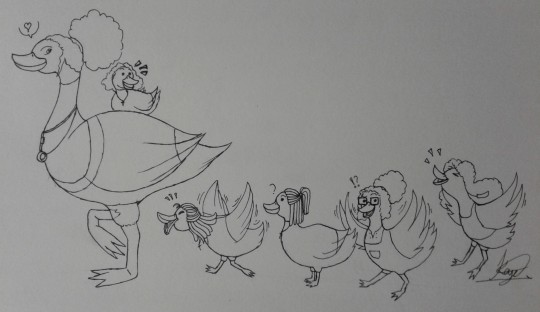
(Youngest gets free rides)
Characters belong to:
Isabella Trastámara - @lexartsstuff
Juan Trastámara - @weirdbutdecentart
Juana Trastámara - @ellielovesdrawing
Marion Trastámara - @vanessaseymour
Maria Trastámara - yours truly
#six#six the musical#sixtended verse#isabella trastámara (sixtended)#juan trastámara (sixtended)#juana trastamara (sixtended)#marion trastámara (sixtended)#maria trastámara (sixtended)#catalina de aragon (six)#catherine of aragon (six)#my art
19 notes
·
View notes
Photo

Maria of Aragon (29 June 1482 – 7 March 1517) was a Spanish infanta, and Queen consort of Portugal as the second spouse of King Manuel I.
60 notes
·
View notes
Text

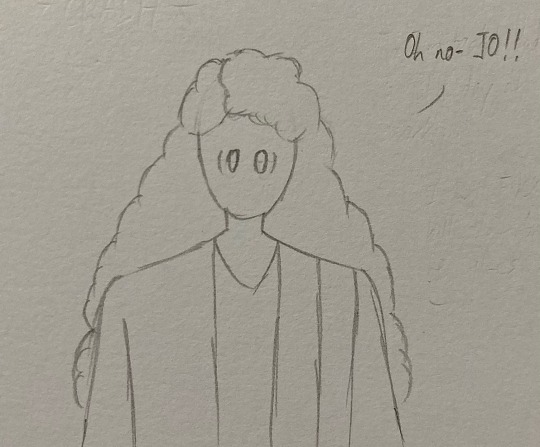
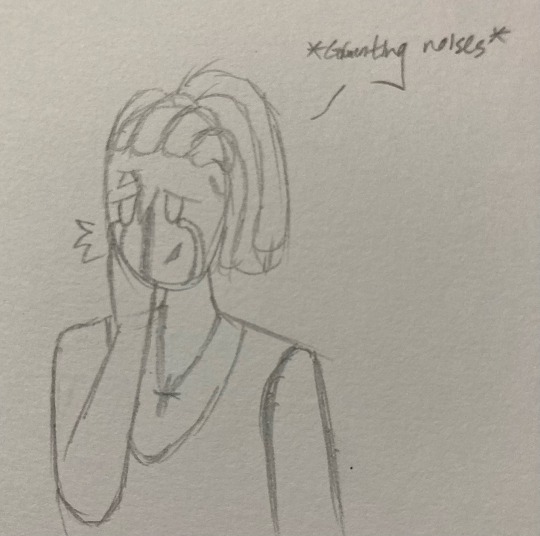

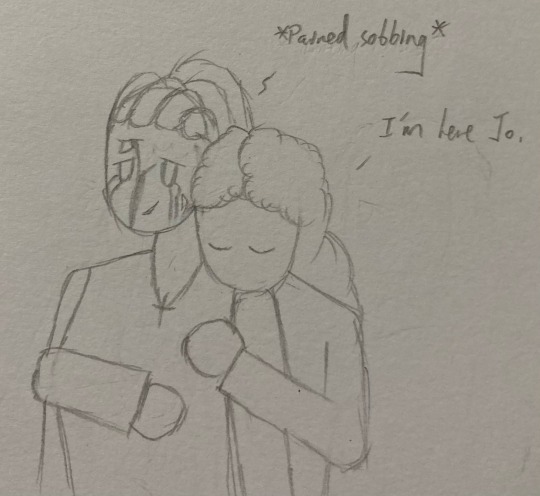
Here’s my half of the art trade that I’m doing with @ellielovesdrawing, she asked for a comic featuring Juana having a tic episode as well as @blackdiamondwrites127’s Maria comforting her.
I’m not entirely sure how to accurately portray those who have similar disorders as Juana, and while research did indicate that hugging could help calm those with Tourette’s down, it’s not to say that it’s applicable to everyone.
So yeah, I tried my best and I’m sorry if this offends anyone.
#six oc#sixtended verse#Juana de Castile (Sixtended)#Maria Trastamara (Sixtended)#tw blood#Art Trade#Altair draws#Galaxy Gifting
14 notes
·
View notes
Photo

a bunch of sketches of suggested witcher characters, for art practice
#milva#maria barring#yennefer of vengerberg#yennefer#iorveth#vernon roche#zoltan chivay#marlene#marlene de trastamara#barnabas-basil foulty#barnabas-basil#the witcher#witcher#my art#debated if i should post this here but then i thought. why not
136 notes
·
View notes
Text
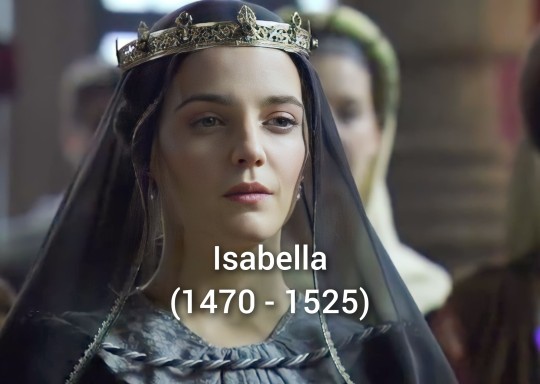
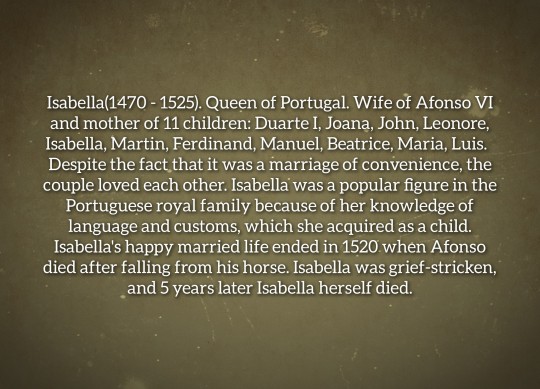
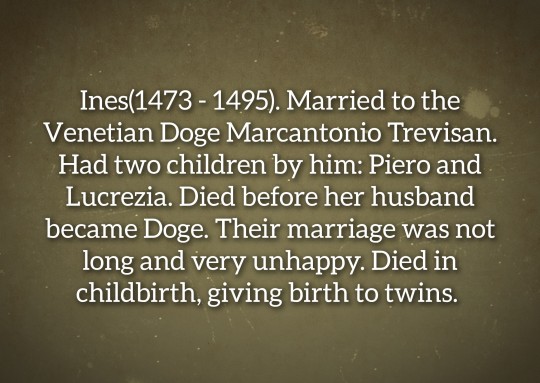
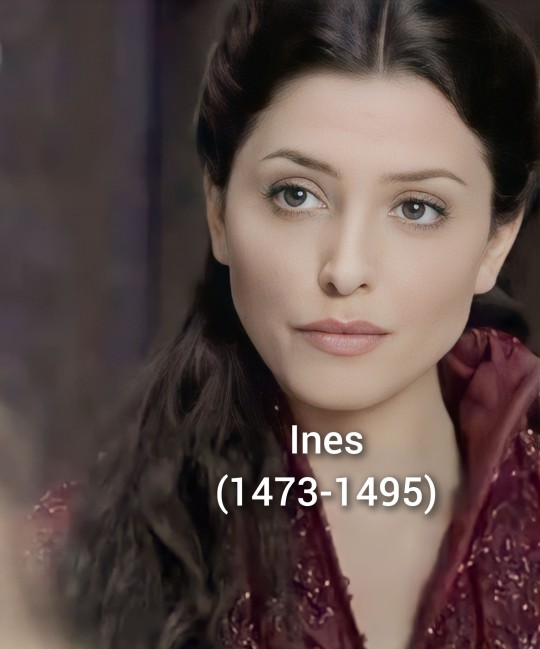
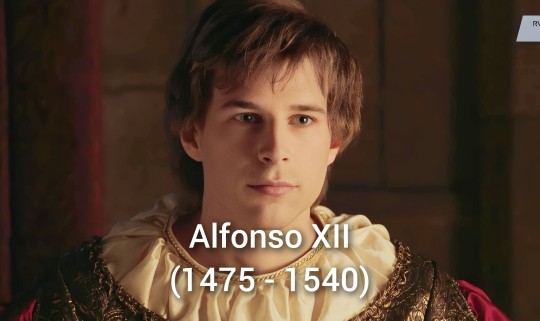
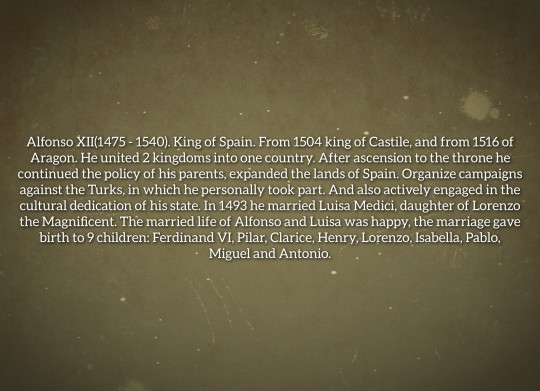
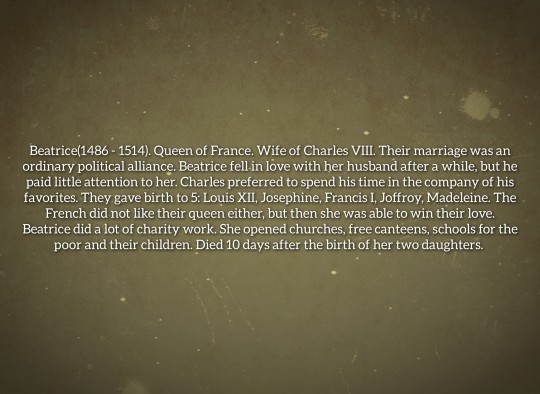
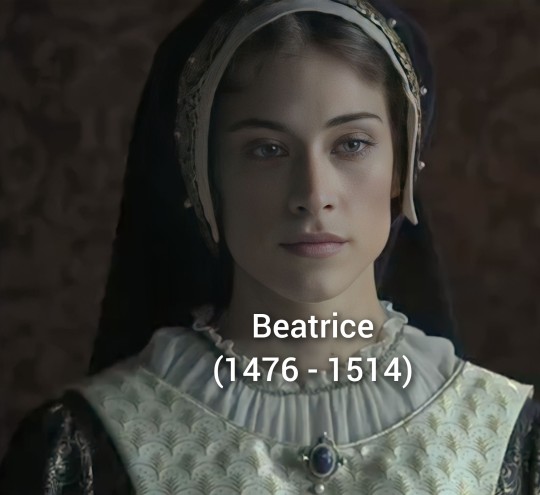


AU House of Trastamara: Children Isabella of Castile and Ferdinand of Aragon.
Isabella(1470 - 1525). Queen of Portugal. Wife of Afonso VI and mother of 11 children: Duarte I, Joana, John, Leonore, Isabella, Martin, Ferdinand, Manuel, Beatrice, Maria, Luis. Despite the fact that it was a marriage of convenience, the couple loved each other. Isabella was a popular figure in the Portuguese royal family because of her knowledge of language and customs, which she acquired as a child. Isabella's happy married life ended in 1520 when Afonso died after falling from his horse. Isabella was grief-stricken, and 5 years later Isabella herself died.
Ines(1473 - 1495). Married to the Venetian Doge Marcantonio Trevisan. Had two children by him: Piero and Lucrezia. Died before her husband became Doge. Their marriage was not long and very unhappy. Died in childbirth, giving birth to twins.
Alfonso XII(1475 - 1540). King of Spain. From 1504 king of Castile, and from 1516 of Aragon. He united 2 kingdoms into one country. After ascension to the throne he continued the policy of his parents, expanded the lands of Spain. Organize campaigns against the Turks, in which he personally took part. And also actively engaged in the cultural dedication of his state. In 1493 he married Luisa Medici, daughter of Lorenzo the Magnificent. The married life of Alfonso and Luisa was happy, the marriage gave birth to 9 children: Ferdinand VI, Pilar, Clarice, Henry, Lorenzo, Isabella, Pablo, Miguel and Antonio.
Beatrice(1486 - 1514). Queen of France. Wife of Charles VIII. Their marriage was an ordinary political alliance. Beatrice fell in love with her husband after a while, but he paid little attention to her. Charles preferred to spend his time in the company of his favorites. They gave birth to 5: Louis XII, Josephine, Francis I, Joffroy, Madeleine. The French did not like their queen either, but then she was able to win their love. Beatrice did a lot of charity work. She opened churches, free canteens, schools for the poor and their children. Died 10 days after the birth of her two daughters.
John(1478 - 1538). Grand Master of the Order of Santiago. Count de Alburquerque. Husband of Margaret of Austria. John loved his wife very much and was always interested in her opinion on any matter. They had 4 children: Sancha, Miguel, Elvira, Ramiro. He was the main advisor of his older brother. Personally participated in all military campaigns. He suffered the death of his wife, survived her by 8 years. He contracted the plague while returning home from a campaign and died a few days later.
AU: Дети Изабеллы Кастильской и Фердинанда Арагонского.
Изабелла(1470 - 1525). Королева Португалии. Жена Афонсу VI и мать 11 детей: Дуарте I, Жуана, Жуан, Леонор, Изабелла, Мартин, Фердинанд, Мануэль, Беатриса, Мария, Луис. Не смотря на то, что брак был по расчёту супруги любили друг друга. Изабелла была популярной фигурой в португальской королевской семье благодаря тому, что имела неплохие познания в языке и обычаях, которые она приобрела ещё в детстве. Счастливая супружеская жизнь Изабеллы окончилась в 1520 году, когда Афонсу погиб упав с лошади. Изабелла была убита горем, а ещё через 5 лет не стало и самой Изабеллы.
Инес(1473 - 1495). Была замужем за веницианским дожем Маркантонио Тревизаном. Родила от него 2 детей: Пьеро и Лукреция. Умерла до того как её муж стал дожем. Их брак был не долгим и очень не счастливым. Умерла при родах, рожая на свет близнецов.
Альфонсо XII(1475 - 1540). Король Испании. С 1504 года король Кастилии, а с 1516 Арагона. Объединил 2 королевства в одну страну. После восшествия на престол продолжил политику своих родителей, расширил земли Испании. Организовывал походы против турок, в которых лично принимал участие. А также активно занимался культурным просвящением своего государства. В 1493 году женился на Луизе Медичи, дочери Лоренцо Великолепного. Супружеская жизнь Альфонсо и Луизы была счастливой, в браке родилось 9 детей: Фердинанд VI, Пилар, Клариче, Энрике, Лоренцо, Изабелла, Пабло, Мигель и Антонио.
Беатриса(1486 - 1514). Королева Франции. Жена Карла VIII. Их брак был обычным политическим союзом. Беатриса через некоторое время полюбила своего мужа, но он уделял ей мало внимания. Карл предпочитал проводить время в обществе своих фавориток. У них родилось 5: Людовик XII, Жозефина, Франциск I, Жоффруа, Мадлен. Французы тоже не долюбливали свою королеву из за того, что она была испанкой, но потом она смогла заваювать их любовь. А когда она умерла, то искренне оплакивали ее кончину. Беатриса занималась благотворительностью: открывала церкви, бесплатные столовые, школы для бедняков и их детей. Умерла через 10 дней после рождения 2 дочери.
Хуан(1478 - 1538). Великий Магистр ордена Сантьяго. Граф де Альбуркерке. Муж Маргариты Австрийской. Хуан очень сильно любил свою жену и всегда интересовался её мнением по любым вопросам. У них родилось 4 детей: Санча, Мигель, Эльвира, Рамиро. Был главным советником своего старшего брата. Лично участвовал во всех военных походах. Тяжело перенёс смерть своей жены, пережил её на 8 лет. Заразился чумой когда возвращался домой из похода и через несколько дней умер.
Part 1.
#history#history au#spain#spanish#spanish history#isabella#IsabellaofCastile#FerdinandofAravon#royal family#royalty#Isabel#catherine of aragon#henry viii#the tudors#mary tudor#15th century#16th century#au#spanish princess#the spanish princess#spanish royal family#spanish royalty#Royal#Royals
6 notes
·
View notes
Photo



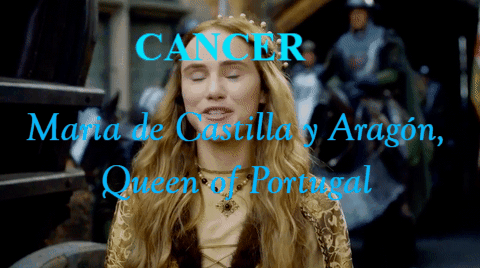

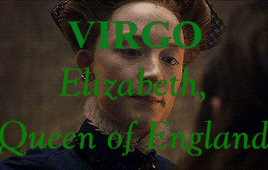




Fᴀᴠᴏᴜʀɪᴛᴇ ʀᴏʏᴀʟs ᴀɴᴅ ᴛʜᴇɪʀ sᴛᴀʀ sɪɢɴs (1):﹕
₁. Aʀɪᴇs﹕ Mᴀʀɢᴜᴇʀɪᴛᴇ ᴅ·Aɴᴊᴏᴜ/Mᴀʀɢᴀʀᴇᴛ ᴏғ Aɴᴊᴏᴜ﹐ Qᴜᴇᴇɴ ᴏғ Eɴɢʟᴀɴᴅ ﹙₂₃ Mᴀʀᴄʜ ₁₄₃₀﹣₂₅ Aᴜɢᴜsᴛ ₁₄₈₂﹚
₂. Tᴀᴜʀᴜs﹕ Lᴏᴜɪs IX﹐ Kɪɴɢ ᴏғ Fʀᴀɴᴄᴇ ﹙₂₅ Aᴘʀɪʟ ₁₂₁₄﹣₂₅ Aᴜɢᴜsᴛ ₁₂₇₀﹚.
₃. Gᴇᴍɪɴɪ﹕ Aɴɴᴇ Nᴇᴠɪʟʟᴇ﹐ Qᴜᴇᴇɴ ᴏғ Eɴɢʟᴀɴᴅ. ﹙₁₁ Jᴜɴᴇ ₁₄₅₆﹣₁₆ Mᴀʀᴄʜ ₁₄₈₅﹚.
₄. Cᴀɴᴄᴇʀ﹕ Mᴀʀɪᴀ ᴏғ Cᴀsᴛɪʟʟᴇ ᴀɴᴅ Aʀᴀɢᴏɴ﹐ Qᴜᴇᴇɴ ᴏғ Pᴏʀᴛᴜɢᴀʟ. ﹙₂₉ Jᴜɴᴇ ₁₄₈₂﹣₇ Mᴀʀᴄʜ ₁₅₁₇﹚.
₅. Lᴇᴏ﹕ Hᴀʀᴛʜᴀᴄɴᴜᴛ﹐ Kɪɴɢ ᴏғ Dᴇɴᴍᴀʀᴋ ᴀɴᴅ Eɴɢʟᴀɴᴅ ﹙ʙᴏʀɴ Jᴜʟʏ/Aᴜɢᴜsᴛ ₁₀₁₈﹣₈ Jᴜɴᴇ ₁₀₄₀﹚.
₆. Vɪʀɢᴏ﹕ Eʟɪᴢᴀʙᴇᴛʜ I﹐ Qᴜᴇᴇɴ ᴏғ Eɴɢʟᴀɴᴅ ﹙₇ Sᴇᴘᴛᴇᴍʙᴇʀ ₁₅₃₃﹣₂₄ Mᴀʀᴄʜ ₁₆₀₃﹚.
₇. Lɪʙʀᴀ﹕ Hᴇɴʀʏ III﹐ Kɪɴɢ ᴏғ Eɴɢʟᴀɴᴅ ﹙₁ Oᴄᴛᴏʙᴇʀ ₁₂₀₇﹣₁₆ Nᴏᴠᴇᴍʙᴇʀ ₁₂₇₂﹚.
₈. Sᴄᴏʀᴘɪᴏ﹕ Oʟɢᴀ Nɪᴋᴏʟᴀᴇᴠɴᴀ Rᴏᴍᴀɴᴏᴠᴀ﹐ Gʀᴀɴᴅ Dᴜᴄʜᴇss ᴏғ Rᴜssɪᴀ ﹙₁₅ Nᴏᴠᴇᴍʙᴇʀ ₁₈₉₅﹣₁₇ Jᴜʟʏ ₁₉₁₈﹚.
₉. Sᴀɢɪᴛᴛᴀʀɪᴜs﹕ Mᴀʀɢᴀʀᴇᴛ Tᴜᴅᴏʀ﹐ Qᴜᴇᴇɴ ᴏғ Sᴄᴏᴛʟᴀɴᴅ. ﹙₂₈ Nᴏᴠᴇᴍʙᴇʀ ₁₄₈₉﹣₁₈ Oᴄᴛᴏʙᴇʀ ₁₅₄₁﹚
₁₀. Cᴀᴘʀɪᴄᴏʀɴ:﹕ Cʜᴀʀʟᴏᴛᴛᴇ Aᴜɢᴜsᴛᴀ ᴏғ Hᴀɴɴᴏᴠᴇʀ﹐ Pʀɪɴᴄᴇss ᴏғ Wᴀʟᴇs ᴀɴᴅ ᴏғ Sᴀxᴇ﹣Cᴏʙʀᴜɢ ᴀɴᴅ Gᴏᴛʜᴀ. ﹙₇ Jᴀɴᴜᴀʀʏ ₁₇₉₆﹣₆ Nᴏᴠᴇᴍʙᴇʀ ₁₈₁₇﹚
#Margaret of Anjou#Marguerite d'Anjou#Queen Margaret#Lancastrian Queen#Henry VI#Louis IX#King Louis IX#Saint-Louis#Anerin Barnard#Cate Blanchette#Anne Neville#Maria of Aragon#Maria of Castille#Rainha Maria#Queen Maria of Portugal#Maria of Trastamara#Harthacnut#Hardicnut#Cnut III#Travis Fimmel#Elizabeth I#Elizabeth Tudor#Queen Elizabeth I#Tudor dynasty#Saoirse Ronan#Henry III#King Henry III#Plantagenet dynasty#Jon Snow#Kit Harrington
11 notes
·
View notes
Photo

Maria Of Trastamara. Infanta Of Castile & Aragon Queen Of Portugal. Her Daughter, Isabella Of Aviz, Infanta Of Potugal & Holy Roman Empress.
#isabel tve#maria of aragon#susana abaitua#house of trastamara#Modern History#Carlos Rey Emperador#Isabella of Portugal#Blanca Suárez#House of Aviz
36 notes
·
View notes